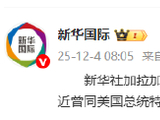Huawei's New AI Chip; Shanghai's Growth; China Agricultural Imports Shift to Brazil; Australia as a New Challenger to Rare Earth Export Restrictions; China-Tunisia Relations; China-Greece Relations

Huawei's New AI Chip: A Strategic Move in Semiconductor Dominance
United Daily News reports that Huawei is on the brink of testing its latest AI chip, the Ascend 910D, in a bid to surpass Nvidia's benchmark H100 chip. Despite facing U.S. sanctions that restrict access to some Western manufacturing equipment, China's semiconductor industry continues its resilient march towards self-reliance. The Ascend 910D aims not only to close the technological gap but also to reduce China's dependency on imported technology. Early testing indicates promising functionality, yet it will require extensive trials to fine-tune its capabilities for Huawei's client base.
The geopolitical implications of Huawei's advancements are vast. The chip's development underscores China's resolve to enhance its technological infrastructure amid ongoing U.S. export controls. By reaching out to Chinese tech firms for testing, Huawei is laying the groundwork for an ecosystem that weans local industries off Western technologies. This could potentially ignite a more significant shift in global tech reliance, potentially affecting Western tech dominance.
The Rise of Shanghai’s "Five Centers"
In an article by The Paper, there's a vivid depiction of Shanghai's ambition to solidify its status as a global metropolis through the development of "Five Centers." The strategy propels Shanghai into a hub of finance, commerce, and technology, striving for an economic modernization that echoes throughout China. These centers include finance, trade, shipping, technology, and an economy center.
The paper emphasizes the multifaceted growth occurring as part of this initiative. Significant economic metrics underscore Shanghai’s progress: a 5.1% GDP growth target for the first quarter of 2025 and notable growth in finance and trade metrics underscore these efforts. Furthermore, technology plays a pivotal role, linking all centers, providing the necessary innovation and support. The article reflects the government’s perspective of relentless forward momentum as a testament to Shanghai's leadership in reform and openness.
This narrative fits into China's broader national strategy to harness urbanization as a tool for economic leverage. For global cities in international finance, innovation becomes a language of continuity versus disruption. It raises a potential challenge to global financial hubs like New York or London by centering local policy on synergy through technological breakthroughs.
China and Agricultural Imports: A Shift to Brazil
Another report from The Paper shines light on China's strategic pivot in agricultural supply chains. As imports from the U.S. reduced, there was a noticeable increase in Brazilian soybeans entering Chinese ports, particularly Ningbo-Zhoushan. This shift reflects the subtle dance of international trade and geopolitical maneuvering.
China’s transition towards Brazilian producers aligns with larger geopolitical moves away from dependence on American agriculture. The dynamics highlight potential vulnerabilities in existing trade pipelines and the PRC's strategy to diversify import sources. While this move enhances trade relations with Brazil, it simultaneously increases competitive pressures within China-U.S. trade talks, impacting global commodity markets as these major global players realign their strategies.
South China's Renewable Energy Surge
Reported by Sina, the South China electric grid's rapid expansion in renewable energy installations marks a significant step in national energy policy. With an 882 MW increase in new energy sources in Q1 2025, the grid bore witness to substantial expansions, particularly in solar and offshore wind.
The narrative reveals China's steadfast commitment to greening its energy consumption, aligning with international climate commitments. This pursuit not only addresses domestic energy needs but positions China as a leader in renewable energy technology exportation, challenging Western counterparts and fostering innovation locally. As these efforts gain momentum, they could reshape global energy market dynamics, reinforcing China's role as a key player in the renewable sector.
U.S.-China Trade Tensions and the Tax Strategy Discourse
The current climate between the U.S. and China reflects escalating trade tensions, which appear to be underlined by complex tax strategies. According to United Daily News, U.S. President Trump's administration is implementing tax policies purported to ease the tax burden on low-income citizens, potentially offering a complete exemption from income tax for those earning $20,000 or less annually. This move, described as offering "great wealth for America," seems tailored to appeal to domestic audiences by promising economic relief while indirectly addressing trade hurdles with China.
This perspective juxtaposes with the economic slowdown in trade volume between the U.S. and China, lending credence to the idea that such policies are also a reactive measure to ongoing trade tariffs. The narrative proposed by CNN and industry analysts suggests that a decrease in trade flow due to tariffs might also trigger domestic shortages, affecting consumer markets and supply chains. These conflicting narratives emphasize the delicate balance of addressing domestic economic policies and international trade tensions concurrently.
Rare Earth Export Restrictions: Australia as a New Challenger
China's recent enforcement of export controls on rare earth minerals has stirred global market dynamics, notably impacting Australia. The BBC highlights Australia's strategic investment in its critical mineral reserves as a potential counter to China's dominance. Australian Prime Minister Anthony Albanese's ambition to allocate A$12 billion towards enhancing its mining capabilities is a direct response to China's restrictions.
This scenario underscores Australia's attempts to position itself strategically against China's stronghold in the mineral refining industry. Still, analysts caution that such endeavors might not immediately unsettle China's entrenched position in the value chain. Although Australia's initiatives could help mitigate some dependency on Chinese exports, the pathway to gaining a competitive edge remains arduous, given China's overwhelming refining capacity and its impact on global prices.
Cross-Cultural Exchanges Featuring China and Beyond
The dynamic cultural exchange forum held in Tunisia exemplifies China's emphasis on promoting cultural ties to enhance diplomatic relations, as reported by People's Daily. This platform facilitated discourse and collaboration in literature and arts, fostering cultural ties between China and participating nations, notably the Arab world.
Such cultural diplomacy initiatives reflect China's broader soft power strategy, where it utilizes cultural connectors to build and reinforce alliances, contrasting with the economic-focused narratives in trade and mineral sectors. The emphasis on long-term cultural affinity and mutual cooperation integrates China's domestic goal of showcasing its leadership in cultural hegemony with its political narratives.
China-Greece Digital Heritage Partnership
In a somewhat different vein, China's cultural intersection with global partners like Greece is advancing through innovative collaborations. At the launch event recently held at Greece's National Archaeological Museum, the "China-Greece Joint Digital Heritage Lab" was inaugurated (People's Daily). This venture marks a significant milestone in cultural preservation and digitization efforts.
The focus is to deepen collaboration in the digitalization of heritage between the two ancient civilizations. Greek Secretary of Culture, Ioannis Giakoumakis, underscored the importance of such cultural exchanges, noting that digital technology serves as a bridge fostering mutual understanding beyond language and regional boundaries. This initiative exemplifies cultural diplomacy, where technology plays a central role in preserving history and sharing it with broader audiences.
Chinese Ambassador Fang Liu sees this as a testament to successful bilateral exchanges and an innovative solution to cultural heritage protection challenges. This project symbolizes an evolving model of international cooperation where culture and technology converge to enhance joint cultural wealth, benefiting humanity.



